Jai Arjun Singh's Blog, page 26
April 12, 2020
A recommendation for Dolemite is my Name...
...which is on Netflix India. Caution: you need a high threshold for profanity, scatological dialogue and “tasteless comedy”, but those things are surface elements here – underneath them is a tender, affectionate film with tremendous heart. This is Eddie Murphy’s tribute to the comedian-singer Rudy Ray Moore and his “Dolemite” persona which became an underground hit in the 1970s, and which was spun off into a film series. Dolemite is my Name covers the period around the birth of that persona – initially employed for nightclub acts – and the earnest but hilariously inept making of the first film, Dolemite.
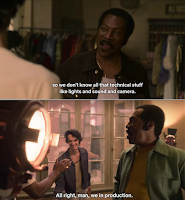 I knew only a little about Moore going in, hadn’t seen any of his work, and had a passing knowledge of the “blaxploitation” subculture of the 70s; this film revitalises him, making him real and relatable in a way comparable to what the 1994 Ed Wood did for another famously “bad” filmmaker. But for me, Dolemite is my Name was also a reminder of Eddie Murphy’s special genius. It’s been a while since I saw him – the last time was probably 20 years ago in his splendid double role in Bowfinger (which, coincidentally, was also about a filmmaking unit with more enthusiasm than talent). He puts everything he has into this role; it was clearly a personal project for him.
I knew only a little about Moore going in, hadn’t seen any of his work, and had a passing knowledge of the “blaxploitation” subculture of the 70s; this film revitalises him, making him real and relatable in a way comparable to what the 1994 Ed Wood did for another famously “bad” filmmaker. But for me, Dolemite is my Name was also a reminder of Eddie Murphy’s special genius. It’s been a while since I saw him – the last time was probably 20 years ago in his splendid double role in Bowfinger (which, coincidentally, was also about a filmmaking unit with more enthusiasm than talent). He puts everything he has into this role; it was clearly a personal project for him.
One idea I thought was poignantly implied here: that even what is widely considered “bad art” can beget good things, through the effect it has on people who for very personal reasons find validation or resonance in it – including marginalised artists who, stirred and encouraged by something they can relate to, go on to create more lasting things themselves. A scene at the end has Rudy Ray Moore, at the crowded late-night premiere of Dolemite, opting not to go into the hall but to hang around outside, entertaining the viewers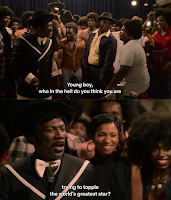 waiting in line for the next show. Among those viewers is a young boy, a huge Rudy fan who can’t believe his luck that his idol is bantering and rapping with him. I haven’t read much around the film, but it struck me that in 1975, when this scene was set, Eddie Murphy himself would have been around the age of this young boy – and I wondered if there was something autobiographical about the scene, or even just a bit of wish-fulfilment in it. Either way, if Murphy has produced and starred in a film this good – which is largely about the making of a “bad” film – it says something about the capacity of low art to inspire and nourish
waiting in line for the next show. Among those viewers is a young boy, a huge Rudy fan who can’t believe his luck that his idol is bantering and rapping with him. I haven’t read much around the film, but it struck me that in 1975, when this scene was set, Eddie Murphy himself would have been around the age of this young boy – and I wondered if there was something autobiographical about the scene, or even just a bit of wish-fulfilment in it. Either way, if Murphy has produced and starred in a film this good – which is largely about the making of a “bad” film – it says something about the capacity of low art to inspire and nourish
P.S. Dolemite is my Name was written by Scott Alexander and Larry Karaszewski, who also scripted Ed Wood. In one of the most moving scenes in the earlier film, there is a suggestion that the talentless Edward Wood and the genius Orson Welles were kindred spirits in a way: misunderstood and persecuted, united by a childlike passion for their medium. A similar, more fleeting analogy is made in Dolemite is my Name, via a mention of John Cassavetes, the very respected director who realised his visions on tiny budgets. I can imagine the ghosts of Cassavetes and Rudy Ray Moore very surprised at finding themselves sharing a cell in a directors' purgatory -- but then overcoming their shyness and getting down to swapping harrowing stories. <!-- /* Font Definitions */ @font-face {font-family:"Cambria Math"; panose-1:2 4 5 3 5 4 6 3 2 4; mso-font-charset:0; mso-generic-font-family:roman; mso-font-pitch:variable; mso-font-signature:3 0 0 0 1 0;} @font-face {font-family:Calibri; panose-1:2 15 5 2 2 2 4 3 2 4; mso-font-charset:0; mso-generic-font-family:swiss; mso-font-pitch:variable; mso-font-signature:-536859905 -1073732485 9 0 511 0;} /* Style Definitions */ p.MsoNormal, li.MsoNormal, div.MsoNormal {mso-style-unhide:no; mso-style-qformat:yes; mso-style-parent:""; margin:0cm; margin-bottom:.0001pt; mso-pagination:widow-orphan; font-size:12.0pt; font-family:"Calibri",sans-serif; mso-ascii-font-family:Calibri; mso-ascii-theme-font:minor-latin; mso-fareast-font-family:Calibri; mso-fareast-theme-font:minor-latin; mso-hansi-font-family:Calibri; mso-hansi-theme-font:minor-latin; mso-bidi-font-family:"Times New Roman"; mso-bidi-theme-font:minor-bidi; mso-fareast-language:EN-US;} .MsoChpDefault {mso-style-type:export-only; mso-default-props:yes; font-family:"Calibri",sans-serif; mso-ascii-font-family:Calibri; mso-ascii-theme-font:minor-latin; mso-fareast-font-family:Calibri; mso-fareast-theme-font:minor-latin; mso-hansi-font-family:Calibri; mso-hansi-theme-font:minor-latin; mso-bidi-font-family:"Times New Roman"; mso-bidi-theme-font:minor-bidi; mso-fareast-language:EN-US;}size:612.0pt 792.0pt; margin:72.0pt 72.0pt 72.0pt 72.0pt; mso-header-margin:36.0pt; mso-footer-margin:36.0pt; mso-paper-source:0;} div.WordSection1 {page:WordSection1;}</span></font></style></div>
 I knew only a little about Moore going in, hadn’t seen any of his work, and had a passing knowledge of the “blaxploitation” subculture of the 70s; this film revitalises him, making him real and relatable in a way comparable to what the 1994 Ed Wood did for another famously “bad” filmmaker. But for me, Dolemite is my Name was also a reminder of Eddie Murphy’s special genius. It’s been a while since I saw him – the last time was probably 20 years ago in his splendid double role in Bowfinger (which, coincidentally, was also about a filmmaking unit with more enthusiasm than talent). He puts everything he has into this role; it was clearly a personal project for him.
I knew only a little about Moore going in, hadn’t seen any of his work, and had a passing knowledge of the “blaxploitation” subculture of the 70s; this film revitalises him, making him real and relatable in a way comparable to what the 1994 Ed Wood did for another famously “bad” filmmaker. But for me, Dolemite is my Name was also a reminder of Eddie Murphy’s special genius. It’s been a while since I saw him – the last time was probably 20 years ago in his splendid double role in Bowfinger (which, coincidentally, was also about a filmmaking unit with more enthusiasm than talent). He puts everything he has into this role; it was clearly a personal project for him.One idea I thought was poignantly implied here: that even what is widely considered “bad art” can beget good things, through the effect it has on people who for very personal reasons find validation or resonance in it – including marginalised artists who, stirred and encouraged by something they can relate to, go on to create more lasting things themselves. A scene at the end has Rudy Ray Moore, at the crowded late-night premiere of Dolemite, opting not to go into the hall but to hang around outside, entertaining the viewers
 waiting in line for the next show. Among those viewers is a young boy, a huge Rudy fan who can’t believe his luck that his idol is bantering and rapping with him. I haven’t read much around the film, but it struck me that in 1975, when this scene was set, Eddie Murphy himself would have been around the age of this young boy – and I wondered if there was something autobiographical about the scene, or even just a bit of wish-fulfilment in it. Either way, if Murphy has produced and starred in a film this good – which is largely about the making of a “bad” film – it says something about the capacity of low art to inspire and nourish
waiting in line for the next show. Among those viewers is a young boy, a huge Rudy fan who can’t believe his luck that his idol is bantering and rapping with him. I haven’t read much around the film, but it struck me that in 1975, when this scene was set, Eddie Murphy himself would have been around the age of this young boy – and I wondered if there was something autobiographical about the scene, or even just a bit of wish-fulfilment in it. Either way, if Murphy has produced and starred in a film this good – which is largely about the making of a “bad” film – it says something about the capacity of low art to inspire and nourishP.S. Dolemite is my Name was written by Scott Alexander and Larry Karaszewski, who also scripted Ed Wood. In one of the most moving scenes in the earlier film, there is a suggestion that the talentless Edward Wood and the genius Orson Welles were kindred spirits in a way: misunderstood and persecuted, united by a childlike passion for their medium. A similar, more fleeting analogy is made in Dolemite is my Name, via a mention of John Cassavetes, the very respected director who realised his visions on tiny budgets. I can imagine the ghosts of Cassavetes and Rudy Ray Moore very surprised at finding themselves sharing a cell in a directors' purgatory -- but then overcoming their shyness and getting down to swapping harrowing stories. <!-- /* Font Definitions */ @font-face {font-family:"Cambria Math"; panose-1:2 4 5 3 5 4 6 3 2 4; mso-font-charset:0; mso-generic-font-family:roman; mso-font-pitch:variable; mso-font-signature:3 0 0 0 1 0;} @font-face {font-family:Calibri; panose-1:2 15 5 2 2 2 4 3 2 4; mso-font-charset:0; mso-generic-font-family:swiss; mso-font-pitch:variable; mso-font-signature:-536859905 -1073732485 9 0 511 0;} /* Style Definitions */ p.MsoNormal, li.MsoNormal, div.MsoNormal {mso-style-unhide:no; mso-style-qformat:yes; mso-style-parent:""; margin:0cm; margin-bottom:.0001pt; mso-pagination:widow-orphan; font-size:12.0pt; font-family:"Calibri",sans-serif; mso-ascii-font-family:Calibri; mso-ascii-theme-font:minor-latin; mso-fareast-font-family:Calibri; mso-fareast-theme-font:minor-latin; mso-hansi-font-family:Calibri; mso-hansi-theme-font:minor-latin; mso-bidi-font-family:"Times New Roman"; mso-bidi-theme-font:minor-bidi; mso-fareast-language:EN-US;} .MsoChpDefault {mso-style-type:export-only; mso-default-props:yes; font-family:"Calibri",sans-serif; mso-ascii-font-family:Calibri; mso-ascii-theme-font:minor-latin; mso-fareast-font-family:Calibri; mso-fareast-theme-font:minor-latin; mso-hansi-font-family:Calibri; mso-hansi-theme-font:minor-latin; mso-bidi-font-family:"Times New Roman"; mso-bidi-theme-font:minor-bidi; mso-fareast-language:EN-US;}size:612.0pt 792.0pt; margin:72.0pt 72.0pt 72.0pt 72.0pt; mso-header-margin:36.0pt; mso-footer-margin:36.0pt; mso-paper-source:0;} div.WordSection1 {page:WordSection1;}</span></font></style></div>
Published on April 12, 2020 00:41
April 8, 2020
“Extroverted” acting, Raghubir Yadav and the new show Panchayat
During a conversation I had with Naseeruddin Shah a few years ago, he proposed that most good actors — as he defined good acting — tended to be introverts. “Even someone like Mr Bachchan,” he said. “As you know I have many reservations about his larger-than-life image and his career choices — but I believe he is basically introverted, and it comes across in the inward-looking quality of his best work.”
Naseer then listed a few extroverted performers, Satish Shah, Boman Irani and Johnny Lever among them. “They are extremely skilful, they can change their voice and be funny and mimic and do brilliant things that will blindside you — but vulnerability is not part of their makeup, because that quality requires introversion; you need to be a little unsure of yourself in real life.”
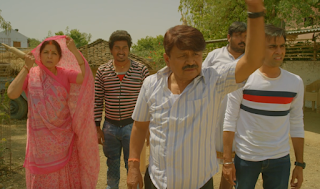 I bring this up because I’m almost sure that Naseer’s list of extroverts had also included Raghubir Yadav. (Can’t verify this because I don’t have the voice recording of the conversation just now, only my incomplete written notes.) And if that was the case, it would be a surprise. Notwithstanding the many ups and downs in Yadav’s career — including a few gaps that were apparently caused by personal problems — he has been one of our finest actors right from the Salaam Bombay and Massey Saheb days. And this post has been a long-winded way of saying that Yadav’s turn as a village “Pradhan-pati” in the new show Panchayat is one of the better things you’ll see this year. Even if there is a touch of what Naseer might call mimicry — in the accent and mannerisms that inform Yadav’s depiction of a provincial man, a biggish frog in a very small well — the performance feels completely authentic and lived-in. He and Neena Gupta (as his wife, who is the actual Pradhan but is made to stay in the background) work wonderfully well together.
I bring this up because I’m almost sure that Naseer’s list of extroverts had also included Raghubir Yadav. (Can’t verify this because I don’t have the voice recording of the conversation just now, only my incomplete written notes.) And if that was the case, it would be a surprise. Notwithstanding the many ups and downs in Yadav’s career — including a few gaps that were apparently caused by personal problems — he has been one of our finest actors right from the Salaam Bombay and Massey Saheb days. And this post has been a long-winded way of saying that Yadav’s turn as a village “Pradhan-pati” in the new show Panchayat is one of the better things you’ll see this year. Even if there is a touch of what Naseer might call mimicry — in the accent and mannerisms that inform Yadav’s depiction of a provincial man, a biggish frog in a very small well — the performance feels completely authentic and lived-in. He and Neena Gupta (as his wife, who is the actual Pradhan but is made to stay in the background) work wonderfully well together.
This charming show — about a young city-dweller named Abhishek (Jitendra Kumar, who was so appealing in Shubh Mangal Zyaada Saavdhan earlier this year) reluctantly taking up a Panchayat secretary post, dealing with ennui and frustration while also studying for an MBA career — may remind some viewers of 1980s Doordarshan serials like Nukkad. Panchayat has a similar languid tone (notwithstanding its occasional use of elaborate drone shots and wide lenses) that fits this setting and works well for a story about an impatient man being forced to adjust to a new pace of life (the way many of us are having to in these Covid-19 days).
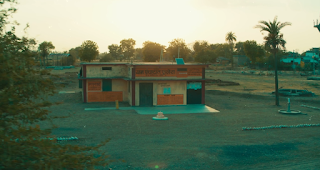 There are occasional bits of forced or thinly stretched out humour, and some episodes are more focused/fleshed-out than others (I particularly liked the series midsection, including episodes 4 and 5 — one of which is about a controversial family-planning message that likens a third child to a piles affliction and causes much angst). But on the whole Panchayat is a fluid watch, easy on the senses, full of little wonders (Anurag Saikia's background score, a local cop trying to play Sherlock Holmes), and it’s the sort of show that it’s good to see being made. Give it a try.
There are occasional bits of forced or thinly stretched out humour, and some episodes are more focused/fleshed-out than others (I particularly liked the series midsection, including episodes 4 and 5 — one of which is about a controversial family-planning message that likens a third child to a piles affliction and causes much angst). But on the whole Panchayat is a fluid watch, easy on the senses, full of little wonders (Anurag Saikia's background score, a local cop trying to play Sherlock Holmes), and it’s the sort of show that it’s good to see being made. Give it a try.
P.S. here is an edited version of that Naseer interview, in The Hindu
Naseer then listed a few extroverted performers, Satish Shah, Boman Irani and Johnny Lever among them. “They are extremely skilful, they can change their voice and be funny and mimic and do brilliant things that will blindside you — but vulnerability is not part of their makeup, because that quality requires introversion; you need to be a little unsure of yourself in real life.”
 I bring this up because I’m almost sure that Naseer’s list of extroverts had also included Raghubir Yadav. (Can’t verify this because I don’t have the voice recording of the conversation just now, only my incomplete written notes.) And if that was the case, it would be a surprise. Notwithstanding the many ups and downs in Yadav’s career — including a few gaps that were apparently caused by personal problems — he has been one of our finest actors right from the Salaam Bombay and Massey Saheb days. And this post has been a long-winded way of saying that Yadav’s turn as a village “Pradhan-pati” in the new show Panchayat is one of the better things you’ll see this year. Even if there is a touch of what Naseer might call mimicry — in the accent and mannerisms that inform Yadav’s depiction of a provincial man, a biggish frog in a very small well — the performance feels completely authentic and lived-in. He and Neena Gupta (as his wife, who is the actual Pradhan but is made to stay in the background) work wonderfully well together.
I bring this up because I’m almost sure that Naseer’s list of extroverts had also included Raghubir Yadav. (Can’t verify this because I don’t have the voice recording of the conversation just now, only my incomplete written notes.) And if that was the case, it would be a surprise. Notwithstanding the many ups and downs in Yadav’s career — including a few gaps that were apparently caused by personal problems — he has been one of our finest actors right from the Salaam Bombay and Massey Saheb days. And this post has been a long-winded way of saying that Yadav’s turn as a village “Pradhan-pati” in the new show Panchayat is one of the better things you’ll see this year. Even if there is a touch of what Naseer might call mimicry — in the accent and mannerisms that inform Yadav’s depiction of a provincial man, a biggish frog in a very small well — the performance feels completely authentic and lived-in. He and Neena Gupta (as his wife, who is the actual Pradhan but is made to stay in the background) work wonderfully well together.This charming show — about a young city-dweller named Abhishek (Jitendra Kumar, who was so appealing in Shubh Mangal Zyaada Saavdhan earlier this year) reluctantly taking up a Panchayat secretary post, dealing with ennui and frustration while also studying for an MBA career — may remind some viewers of 1980s Doordarshan serials like Nukkad. Panchayat has a similar languid tone (notwithstanding its occasional use of elaborate drone shots and wide lenses) that fits this setting and works well for a story about an impatient man being forced to adjust to a new pace of life (the way many of us are having to in these Covid-19 days).
 There are occasional bits of forced or thinly stretched out humour, and some episodes are more focused/fleshed-out than others (I particularly liked the series midsection, including episodes 4 and 5 — one of which is about a controversial family-planning message that likens a third child to a piles affliction and causes much angst). But on the whole Panchayat is a fluid watch, easy on the senses, full of little wonders (Anurag Saikia's background score, a local cop trying to play Sherlock Holmes), and it’s the sort of show that it’s good to see being made. Give it a try.
There are occasional bits of forced or thinly stretched out humour, and some episodes are more focused/fleshed-out than others (I particularly liked the series midsection, including episodes 4 and 5 — one of which is about a controversial family-planning message that likens a third child to a piles affliction and causes much angst). But on the whole Panchayat is a fluid watch, easy on the senses, full of little wonders (Anurag Saikia's background score, a local cop trying to play Sherlock Holmes), and it’s the sort of show that it’s good to see being made. Give it a try.P.S. here is an edited version of that Naseer interview, in The Hindu
Published on April 08, 2020 08:22
March 26, 2020
Feeding street animals in Corona time
(The feeding pics here are from this morning, at PVR Saket. The last image is taken from the Facebook page of my friend Hemali Sodhi; it's a bit soppy, but so is much of life, I have come to think)
In recent days, when walking Lara downstairs, or walking for provisions through colony roads so quiet that I imagine I can hear every leaf that falls from every tree, it’s been possible to appreciate how healthy and idyllic the natural world is when disinfected of most human activity. A few days back I saw six young tailless peacocks walking in single formation along one of our lanes; otherwise one rarely sees more than two together at a time. And it turns out the air-quality index can reset fast in even a place like Delhi.
 It would be too easy — especially for a long-time misanthrope like yours truly— to turn this into a reductive “humans are the real virus/we are the most destructive species” meme. But because a large part of my life in recent years has been organised around street dogs, and because these are very social animals who not just depend on humans for food but also genuinely like being around us (even as they learn to become wary of the many people who dislike them), I have also had access to another vantage point. Namely, how sad and lonesome and empty a human-free world might look like through the eyes of a creature that has evolved socially alongside us over tens of thousands of years, become one of our most steadfast companions, emotionally enriching many of us along the way.
It would be too easy — especially for a long-time misanthrope like yours truly— to turn this into a reductive “humans are the real virus/we are the most destructive species” meme. But because a large part of my life in recent years has been organised around street dogs, and because these are very social animals who not just depend on humans for food but also genuinely like being around us (even as they learn to become wary of the many people who dislike them), I have also had access to another vantage point. Namely, how sad and lonesome and empty a human-free world might look like through the eyes of a creature that has evolved socially alongside us over tens of thousands of years, become one of our most steadfast companions, emotionally enriching many of us along the way.
At a personal, immediate level, what’s been most difficult for me the last few days is hearing the new urgency in the barking of the colony dogs in the far distance. Plus the very nervous, agitated or watchful reactions of my home/part-time-home dogs (across two flats) as they hear distress calls from other members of their species. Or the sudden growling when they sense that an unfamiliar creature, terrified and hungry, has drifted into their territory in search of food.
 As I mentioned in a Facebook post a few days ago, the dogs living in the PVR complex in Saket (that is, the ones who aren’t being regularly fed by Pratima Devi) have been looked after for years by individual shops and dhabas and secondhand-book vendors. People who have now had to shut shop and head home. Yesterday evening, along with Moutushi Sarkar — co-author of the dog book I am still hoping to get done at some point — I set off to check on the PVR situation. Part of me was prepared for the worst: for the sight of dozens of ravenous dogs fighting each other viciously for food, threatening humans too; an unmanageable situation where our packets of biscuits and paneer would amount to nothing. (And no point being idealistic or sanguine about this: such things *are* probably happening in many other places, and will continue if things get worse and stay worse for weeks.)
As I mentioned in a Facebook post a few days ago, the dogs living in the PVR complex in Saket (that is, the ones who aren’t being regularly fed by Pratima Devi) have been looked after for years by individual shops and dhabas and secondhand-book vendors. People who have now had to shut shop and head home. Yesterday evening, along with Moutushi Sarkar — co-author of the dog book I am still hoping to get done at some point — I set off to check on the PVR situation. Part of me was prepared for the worst: for the sight of dozens of ravenous dogs fighting each other viciously for food, threatening humans too; an unmanageable situation where our packets of biscuits and paneer would amount to nothing. (And no point being idealistic or sanguine about this: such things *are* probably happening in many other places, and will continue if things get worse and stay worse for weeks.)
Instead we saw small signs, even in a spookily deserted and quiet complex, of the strength of this magical inter-species relationship. A young boy who worked at a dhaba, has to continue living in the complex because he has nowhere else to go, cooks his own daily meals with the most meagre resources, but still worries about the animals he knows well. The elderly bookseller who, filled with unrest, somehow managed to leave his house after two days and make his way back to the complex just to check on his dogs and cats (and gave us instructions about what each animal is likely to eat). The parking-lot attendant and the chowkidar who, despite being in dire straits themselves, were doing what they could for a litter of pups.
Moutushi and I and a couple of others are trying to coordinate efforts towards some regular/semi-regular feeding. It probably won’t be enough (what is ever “enough” anyway, even in a non-Covid time?), and as stocks deplete everywhere there may be enormous frustrations to come. For some of us, it can be a big emotional/mental-health risk at a time like this to take on the responsibility of regularly feeding specific street dogs and pups: they very quickly go from being a mass of yapping abstractions to individual creatures with personalities, they start communicating with you in their own distinct ways (my two big life-altering relationships with dogs began in this way, in the same colony lane, seven years apart) — and if we are forced to stop the feeding it will be devastating. But it’s a risk one has to take. We do what we can.
responsibility of regularly feeding specific street dogs and pups: they very quickly go from being a mass of yapping abstractions to individual creatures with personalities, they start communicating with you in their own distinct ways (my two big life-altering relationships with dogs began in this way, in the same colony lane, seven years apart) — and if we are forced to stop the feeding it will be devastating. But it’s a risk one has to take. We do what we can.
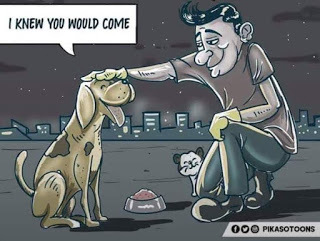
In recent days, when walking Lara downstairs, or walking for provisions through colony roads so quiet that I imagine I can hear every leaf that falls from every tree, it’s been possible to appreciate how healthy and idyllic the natural world is when disinfected of most human activity. A few days back I saw six young tailless peacocks walking in single formation along one of our lanes; otherwise one rarely sees more than two together at a time. And it turns out the air-quality index can reset fast in even a place like Delhi.
 It would be too easy — especially for a long-time misanthrope like yours truly— to turn this into a reductive “humans are the real virus/we are the most destructive species” meme. But because a large part of my life in recent years has been organised around street dogs, and because these are very social animals who not just depend on humans for food but also genuinely like being around us (even as they learn to become wary of the many people who dislike them), I have also had access to another vantage point. Namely, how sad and lonesome and empty a human-free world might look like through the eyes of a creature that has evolved socially alongside us over tens of thousands of years, become one of our most steadfast companions, emotionally enriching many of us along the way.
It would be too easy — especially for a long-time misanthrope like yours truly— to turn this into a reductive “humans are the real virus/we are the most destructive species” meme. But because a large part of my life in recent years has been organised around street dogs, and because these are very social animals who not just depend on humans for food but also genuinely like being around us (even as they learn to become wary of the many people who dislike them), I have also had access to another vantage point. Namely, how sad and lonesome and empty a human-free world might look like through the eyes of a creature that has evolved socially alongside us over tens of thousands of years, become one of our most steadfast companions, emotionally enriching many of us along the way.At a personal, immediate level, what’s been most difficult for me the last few days is hearing the new urgency in the barking of the colony dogs in the far distance. Plus the very nervous, agitated or watchful reactions of my home/part-time-home dogs (across two flats) as they hear distress calls from other members of their species. Or the sudden growling when they sense that an unfamiliar creature, terrified and hungry, has drifted into their territory in search of food.
 As I mentioned in a Facebook post a few days ago, the dogs living in the PVR complex in Saket (that is, the ones who aren’t being regularly fed by Pratima Devi) have been looked after for years by individual shops and dhabas and secondhand-book vendors. People who have now had to shut shop and head home. Yesterday evening, along with Moutushi Sarkar — co-author of the dog book I am still hoping to get done at some point — I set off to check on the PVR situation. Part of me was prepared for the worst: for the sight of dozens of ravenous dogs fighting each other viciously for food, threatening humans too; an unmanageable situation where our packets of biscuits and paneer would amount to nothing. (And no point being idealistic or sanguine about this: such things *are* probably happening in many other places, and will continue if things get worse and stay worse for weeks.)
As I mentioned in a Facebook post a few days ago, the dogs living in the PVR complex in Saket (that is, the ones who aren’t being regularly fed by Pratima Devi) have been looked after for years by individual shops and dhabas and secondhand-book vendors. People who have now had to shut shop and head home. Yesterday evening, along with Moutushi Sarkar — co-author of the dog book I am still hoping to get done at some point — I set off to check on the PVR situation. Part of me was prepared for the worst: for the sight of dozens of ravenous dogs fighting each other viciously for food, threatening humans too; an unmanageable situation where our packets of biscuits and paneer would amount to nothing. (And no point being idealistic or sanguine about this: such things *are* probably happening in many other places, and will continue if things get worse and stay worse for weeks.)Instead we saw small signs, even in a spookily deserted and quiet complex, of the strength of this magical inter-species relationship. A young boy who worked at a dhaba, has to continue living in the complex because he has nowhere else to go, cooks his own daily meals with the most meagre resources, but still worries about the animals he knows well. The elderly bookseller who, filled with unrest, somehow managed to leave his house after two days and make his way back to the complex just to check on his dogs and cats (and gave us instructions about what each animal is likely to eat). The parking-lot attendant and the chowkidar who, despite being in dire straits themselves, were doing what they could for a litter of pups.
Moutushi and I and a couple of others are trying to coordinate efforts towards some regular/semi-regular feeding. It probably won’t be enough (what is ever “enough” anyway, even in a non-Covid time?), and as stocks deplete everywhere there may be enormous frustrations to come. For some of us, it can be a big emotional/mental-health risk at a time like this to take on the
 responsibility of regularly feeding specific street dogs and pups: they very quickly go from being a mass of yapping abstractions to individual creatures with personalities, they start communicating with you in their own distinct ways (my two big life-altering relationships with dogs began in this way, in the same colony lane, seven years apart) — and if we are forced to stop the feeding it will be devastating. But it’s a risk one has to take. We do what we can.
responsibility of regularly feeding specific street dogs and pups: they very quickly go from being a mass of yapping abstractions to individual creatures with personalities, they start communicating with you in their own distinct ways (my two big life-altering relationships with dogs began in this way, in the same colony lane, seven years apart) — and if we are forced to stop the feeding it will be devastating. But it’s a risk one has to take. We do what we can.
Published on March 26, 2020 01:41
March 20, 2020
“Each of us is made of stories” – a folk-hero, a fabulous moustache, and an ecology
[Did this review – of a fascinating if occasionally meandering new novel – for Open magazine]
---------------------
S Hareesh’s novel Moustache (originally published as Meesha in Malayalam) opens with the suggestion that the pangolin – the animal known in Kerala as eenampechi – is “somewhat stupid”, even though it is often regarded as a divinity. A man who has picked up a ball-shaped pangolin for his children hears it calling out to him. Shortly after this, we are told about the snakehead murrel, called Paappu by the region’s fishermen – “the king of the numerous canals and waterways around Neendoor and Kaipuzha” – and about how a boat darts out of this fish’s path even though the person rowing it doesn’t know what has happened.
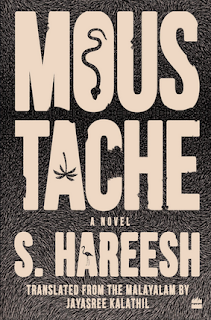 Already, in the novel’s first two pages, there is a powerful sense of interconnectedness between living and non-living things and their environment (the watery Kuttanad terrain, where below-sea-level farming is carried out and complex caste politics are at play). This will grow more pronounced as the story continues. I hadn’t read Hareesh’s previous work, but a similar vibe runs through Lijo Jose Pellissery’s 2019 film Jallikattu, for which Hareesh wrote the screenplay. In that film’s opening sequence, a montage of closeups of people in stages of sleep or wakefulness is followed by dawn images of insects going about their day’s work and a panoramic long take of the rising sun; the background score is made up of sounds from the natural world, including the bellowing of the runaway bull whose pursuit will fuel the story.
Already, in the novel’s first two pages, there is a powerful sense of interconnectedness between living and non-living things and their environment (the watery Kuttanad terrain, where below-sea-level farming is carried out and complex caste politics are at play). This will grow more pronounced as the story continues. I hadn’t read Hareesh’s previous work, but a similar vibe runs through Lijo Jose Pellissery’s 2019 film Jallikattu, for which Hareesh wrote the screenplay. In that film’s opening sequence, a montage of closeups of people in stages of sleep or wakefulness is followed by dawn images of insects going about their day’s work and a panoramic long take of the rising sun; the background score is made up of sounds from the natural world, including the bellowing of the runaway bull whose pursuit will fuel the story.
Moustache is also about an evasive, enigmatic being: a young man named Vavachan, from the lower-caste Pulayan community, who acquires larger-than-life status after appearing in a local play with a big moustache on his face. There is something hypnotic and primal about the passage where Vavachan, made up as a fierce policeman, scares the play’s unprepared audience: it is like a description of the first ever performance of a new art form, or the story of the Parisian viewers terrified during an 1895 Lumiere Brothers screening. This visceral quality will recur elsewhere in the novel, which segues from being a near-anthropological description of a region and its people, set mainly in the first half of the 20th century, to something more allegorical. As Vavachan (who becomes known as Moustache) moves through this landscape, fantastic legends come up around him; people feverishly exaggerate their sightings of the enormous moustache; his presence is even incorporated into incidents that took place, if they took place at all, much before he was born.
What Vavachan himself wants is to go to Malaya – and presumably to a different sort of life – having been inspired by two travellers whom he once met. Later he searches for a woman named Seetha, with whom he had a brief, interrupted encounter, and this paves the way for the Ramayana allusions that flow under the book’s surface. But is Moustache a version of Rama or Ravana? It depends on how you look at the story, and on who is doing the telling. Many oral legends are retrofitted onto the Moustache mythos, which echoes the way our ancient epics acquire new form as they pass from one time and region to another. We are told, for example, that in a place called Kainadi, Moustache is not as imposing or invincible as he is in other lore; he is bettered by another powerful figure.
This is not an organised or linear narrative: it coils back on itself, makes detours; there is a reference to a peripheral character, and we are led down a sinuous new path to learn something about this person’s story. And throughout, there is the non-human world, humming away in the background. When an unfortunate toddy tapper is killed by “a clever Chemballi fish”, we learn that “the fish in his mouth remembered the history of its kind and of humankind, and deciding to die valiantly, it wriggled, making the Chovan inadvertently open his mouth. It slid down his throat into his stomach.” A confused leopard, confronted by a man who performs a martial dance, backs away, and this causes embarrassment for leopards in general. Two old turtles discuss the strange ways of people. Tapioca plants, their branches “raised to the sky”, resemble preachers. Towards the end of one moving chapter, a crocodile, overhearing a conversation between two men, realises that his wife – who had eggs in her belly – has been captured and killed, and that this leaves him as the Last Crocodile. Sentience is equally ascribed to non-living things: a river is lost in thought about the thousands of years before people first came to its shore.
Some of these descriptions invoke the mode of magic realism, which is generally perceived as being out of fashion today; the ghosts of such writers as Gabriel Garcia Marquez loom over this book, as in the early passage where we are told – in a bit of portentous foreshadowing – that “at that precise moment something had been set in motion, and [Paviyan] and his son Vavachan would soon be tricked and sent astray”.
In a casual writer’s hands, this mode is privy to lazy, “anything goes” storytelling. But Hareesh is not lazy or casual (if anything, it sometimes feels like he has too many balls in the air), and the Vavachan legend is explicitly deconstructed in framing interludes where a present-day narrator tries to impress his little son. This provides important context for the book’s magic realism. A theme here is the nature of narration itself: how people (or animals, or plants, or landscapes) get new meaning and extended life when stories are told about them. This is as true of Moustache and other humans as it is of the coconut tree that recognises a person by his voice; or the dying sardine in a basket of freshly caught fish, feeling guilty because it was he who had led the school to the water’s surface.
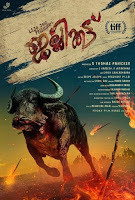 Such descriptions, however strange, feel organic to a story about all life being interconnected in too many ways to count, and about ecological decline. When the narrator tells his son about Vavachan/Moustache staying in a canal for a couple of weeks because fish and frogs had laid eggs in his moustache and he wanted to wait for the eggs to safely hatch, there is a clear link with the sad story of the crocodile whose eggs didn’t get a chance. That captured pangolin in the book’s opening scene may well be calling out to its brethren in China, where the mercilessly traded animal is believed to have played a part in the spread of the Coronavirus.
Such descriptions, however strange, feel organic to a story about all life being interconnected in too many ways to count, and about ecological decline. When the narrator tells his son about Vavachan/Moustache staying in a canal for a couple of weeks because fish and frogs had laid eggs in his moustache and he wanted to wait for the eggs to safely hatch, there is a clear link with the sad story of the crocodile whose eggs didn’t get a chance. That captured pangolin in the book’s opening scene may well be calling out to its brethren in China, where the mercilessly traded animal is believed to have played a part in the spread of the Coronavirus.
****
In one counterintuitive but sharply observed passage, the narrator, after hearing that his son has been told ghosts don’t exist, says: “Don’t they realise how dangerous it is to fill the minds of small children with rationalism? Rationalism […] completely kills a person’s imagination and instincts.” He tries to explain to the boy how different things were in the old times – no electricity, so much flora that even the moonlight couldn’t get through. Here is an elegy for a time when there was a greater sense of wonder and the world seemed more magical than it does today. And an argument, too, for the importance of fantasy. In an early passage, the narrator is mocked at a literary event for suggesting that fables such as the one of the crocodile befriending the monkey are among the best stories in the world, that everything doesn’t have to be political or difficult or provide a moral compass; that a good story is an entertaining one. This might seem simplistic, but it has a more layered undercurrent: even seemingly “non-political” stories can have important things to say about a time and place.
Though this isn’t explicitly stated, the Vavachan story suggests that wonder and imagination can help us overcome the many discriminatory lines drawn in our world. They might enable a lower-caste man to see himself as equal to others, and for people to look upon him as a hero or an imposing figure. The creative process – working with the drama troupe – changes Vavachan: earlier, like the others in his family, he was accustomed to hunger, but now, “unlike other Pulayans, he would no longer be able to live without food or draw energy from the wind or the sun […] now he was looking for the road to a place where he imagined kanji was plentiful and always within reach”. In putting on a new face, he has been transformed, and he is in turn transforming the community around him. But there is also a caution about the limits of fantasy: the myths that grow around Vavachan imprison him in some ways, as they do Seetha and other people. (When Moustache and Seetha are “reunited”, she behaves like a mythological character trying to break free of the grand songs and legends about her.)
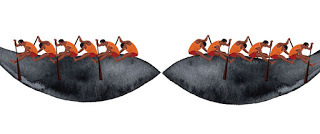 Even if its principal mode is that of exaggeration, surrealism or fairy-tale, Moustache is steeped in the realities of a land, its history and its people. The scope of this book is audacious (it is as if the author decided to do a condensed version of the ledger maintained by the god of death, which is referred to in the narrative: the book that contains all things, past, present and future) and there are many discoveries to be made for a reader unfamiliar with the setting and culture. At one point we are told that a boatman would not be able to get across these fields “even if he rowed till the end of his life. They had no end, like the earth itself”. It feels strange to read this if you think of Kerala as a sliver of a state, but as translator Jayasree Kalathil says in her note, the more she travelled within Kuttanad, the more it revealed its uniqueness, upsetting the tendency to see Kerala as a limited geographical area uniform in culture and language.
Even if its principal mode is that of exaggeration, surrealism or fairy-tale, Moustache is steeped in the realities of a land, its history and its people. The scope of this book is audacious (it is as if the author decided to do a condensed version of the ledger maintained by the god of death, which is referred to in the narrative: the book that contains all things, past, present and future) and there are many discoveries to be made for a reader unfamiliar with the setting and culture. At one point we are told that a boatman would not be able to get across these fields “even if he rowed till the end of his life. They had no end, like the earth itself”. It feels strange to read this if you think of Kerala as a sliver of a state, but as translator Jayasree Kalathil says in her note, the more she travelled within Kuttanad, the more it revealed its uniqueness, upsetting the tendency to see Kerala as a limited geographical area uniform in culture and language.
So vast is Hareesh’s canvas that it can be exhausting just to keep pace with it. (Jallikattu notwithstanding, a closer cinematic analogy may be with Terrence Malick’s wide-ranging, very abstract film Tree of Life.) Partly because of its unusual structure, partly because there is so much happening on almost every page, Moustache is not an easy read. Around the midway mark, as the story moved away from Vavachan and to a range of other characters, the book became a bit of a slog for me, some passages as hard to negotiate as the countless canals and waterways of the terrain; it was like drowning in detail. One feels sheepish suggesting that a story, being deeply rooted in a specific place, doesn’t translate easily, but at times I felt the enormity of Kalathil’s task as translator, trying to be faithful to the original while also explaining things to a new reader.
And yet, writing this review many days after finishing the book, many passages still linger in my mind, more vividly than when I first read them. I think Moustache works best if treated as a collection of tales and vignettes, linked – sometimes tenuously – by the device of a shadowy figure. As such, it may be advisable to read it not in two or three quick sittings but over a long period – to return to it and dip into it for the atmosphere, for the presentation of a living, throbbing world in all its shades, and a reminder that “each of us is made of the stories told of us”.
[A few earlier pieces for Open magazine are here]
---------------------
S Hareesh’s novel Moustache (originally published as Meesha in Malayalam) opens with the suggestion that the pangolin – the animal known in Kerala as eenampechi – is “somewhat stupid”, even though it is often regarded as a divinity. A man who has picked up a ball-shaped pangolin for his children hears it calling out to him. Shortly after this, we are told about the snakehead murrel, called Paappu by the region’s fishermen – “the king of the numerous canals and waterways around Neendoor and Kaipuzha” – and about how a boat darts out of this fish’s path even though the person rowing it doesn’t know what has happened.
 Already, in the novel’s first two pages, there is a powerful sense of interconnectedness between living and non-living things and their environment (the watery Kuttanad terrain, where below-sea-level farming is carried out and complex caste politics are at play). This will grow more pronounced as the story continues. I hadn’t read Hareesh’s previous work, but a similar vibe runs through Lijo Jose Pellissery’s 2019 film Jallikattu, for which Hareesh wrote the screenplay. In that film’s opening sequence, a montage of closeups of people in stages of sleep or wakefulness is followed by dawn images of insects going about their day’s work and a panoramic long take of the rising sun; the background score is made up of sounds from the natural world, including the bellowing of the runaway bull whose pursuit will fuel the story.
Already, in the novel’s first two pages, there is a powerful sense of interconnectedness between living and non-living things and their environment (the watery Kuttanad terrain, where below-sea-level farming is carried out and complex caste politics are at play). This will grow more pronounced as the story continues. I hadn’t read Hareesh’s previous work, but a similar vibe runs through Lijo Jose Pellissery’s 2019 film Jallikattu, for which Hareesh wrote the screenplay. In that film’s opening sequence, a montage of closeups of people in stages of sleep or wakefulness is followed by dawn images of insects going about their day’s work and a panoramic long take of the rising sun; the background score is made up of sounds from the natural world, including the bellowing of the runaway bull whose pursuit will fuel the story.Moustache is also about an evasive, enigmatic being: a young man named Vavachan, from the lower-caste Pulayan community, who acquires larger-than-life status after appearing in a local play with a big moustache on his face. There is something hypnotic and primal about the passage where Vavachan, made up as a fierce policeman, scares the play’s unprepared audience: it is like a description of the first ever performance of a new art form, or the story of the Parisian viewers terrified during an 1895 Lumiere Brothers screening. This visceral quality will recur elsewhere in the novel, which segues from being a near-anthropological description of a region and its people, set mainly in the first half of the 20th century, to something more allegorical. As Vavachan (who becomes known as Moustache) moves through this landscape, fantastic legends come up around him; people feverishly exaggerate their sightings of the enormous moustache; his presence is even incorporated into incidents that took place, if they took place at all, much before he was born.
What Vavachan himself wants is to go to Malaya – and presumably to a different sort of life – having been inspired by two travellers whom he once met. Later he searches for a woman named Seetha, with whom he had a brief, interrupted encounter, and this paves the way for the Ramayana allusions that flow under the book’s surface. But is Moustache a version of Rama or Ravana? It depends on how you look at the story, and on who is doing the telling. Many oral legends are retrofitted onto the Moustache mythos, which echoes the way our ancient epics acquire new form as they pass from one time and region to another. We are told, for example, that in a place called Kainadi, Moustache is not as imposing or invincible as he is in other lore; he is bettered by another powerful figure.
This is not an organised or linear narrative: it coils back on itself, makes detours; there is a reference to a peripheral character, and we are led down a sinuous new path to learn something about this person’s story. And throughout, there is the non-human world, humming away in the background. When an unfortunate toddy tapper is killed by “a clever Chemballi fish”, we learn that “the fish in his mouth remembered the history of its kind and of humankind, and deciding to die valiantly, it wriggled, making the Chovan inadvertently open his mouth. It slid down his throat into his stomach.” A confused leopard, confronted by a man who performs a martial dance, backs away, and this causes embarrassment for leopards in general. Two old turtles discuss the strange ways of people. Tapioca plants, their branches “raised to the sky”, resemble preachers. Towards the end of one moving chapter, a crocodile, overhearing a conversation between two men, realises that his wife – who had eggs in her belly – has been captured and killed, and that this leaves him as the Last Crocodile. Sentience is equally ascribed to non-living things: a river is lost in thought about the thousands of years before people first came to its shore.
Some of these descriptions invoke the mode of magic realism, which is generally perceived as being out of fashion today; the ghosts of such writers as Gabriel Garcia Marquez loom over this book, as in the early passage where we are told – in a bit of portentous foreshadowing – that “at that precise moment something had been set in motion, and [Paviyan] and his son Vavachan would soon be tricked and sent astray”.
In a casual writer’s hands, this mode is privy to lazy, “anything goes” storytelling. But Hareesh is not lazy or casual (if anything, it sometimes feels like he has too many balls in the air), and the Vavachan legend is explicitly deconstructed in framing interludes where a present-day narrator tries to impress his little son. This provides important context for the book’s magic realism. A theme here is the nature of narration itself: how people (or animals, or plants, or landscapes) get new meaning and extended life when stories are told about them. This is as true of Moustache and other humans as it is of the coconut tree that recognises a person by his voice; or the dying sardine in a basket of freshly caught fish, feeling guilty because it was he who had led the school to the water’s surface.
 Such descriptions, however strange, feel organic to a story about all life being interconnected in too many ways to count, and about ecological decline. When the narrator tells his son about Vavachan/Moustache staying in a canal for a couple of weeks because fish and frogs had laid eggs in his moustache and he wanted to wait for the eggs to safely hatch, there is a clear link with the sad story of the crocodile whose eggs didn’t get a chance. That captured pangolin in the book’s opening scene may well be calling out to its brethren in China, where the mercilessly traded animal is believed to have played a part in the spread of the Coronavirus.
Such descriptions, however strange, feel organic to a story about all life being interconnected in too many ways to count, and about ecological decline. When the narrator tells his son about Vavachan/Moustache staying in a canal for a couple of weeks because fish and frogs had laid eggs in his moustache and he wanted to wait for the eggs to safely hatch, there is a clear link with the sad story of the crocodile whose eggs didn’t get a chance. That captured pangolin in the book’s opening scene may well be calling out to its brethren in China, where the mercilessly traded animal is believed to have played a part in the spread of the Coronavirus.****
In one counterintuitive but sharply observed passage, the narrator, after hearing that his son has been told ghosts don’t exist, says: “Don’t they realise how dangerous it is to fill the minds of small children with rationalism? Rationalism […] completely kills a person’s imagination and instincts.” He tries to explain to the boy how different things were in the old times – no electricity, so much flora that even the moonlight couldn’t get through. Here is an elegy for a time when there was a greater sense of wonder and the world seemed more magical than it does today. And an argument, too, for the importance of fantasy. In an early passage, the narrator is mocked at a literary event for suggesting that fables such as the one of the crocodile befriending the monkey are among the best stories in the world, that everything doesn’t have to be political or difficult or provide a moral compass; that a good story is an entertaining one. This might seem simplistic, but it has a more layered undercurrent: even seemingly “non-political” stories can have important things to say about a time and place.
Though this isn’t explicitly stated, the Vavachan story suggests that wonder and imagination can help us overcome the many discriminatory lines drawn in our world. They might enable a lower-caste man to see himself as equal to others, and for people to look upon him as a hero or an imposing figure. The creative process – working with the drama troupe – changes Vavachan: earlier, like the others in his family, he was accustomed to hunger, but now, “unlike other Pulayans, he would no longer be able to live without food or draw energy from the wind or the sun […] now he was looking for the road to a place where he imagined kanji was plentiful and always within reach”. In putting on a new face, he has been transformed, and he is in turn transforming the community around him. But there is also a caution about the limits of fantasy: the myths that grow around Vavachan imprison him in some ways, as they do Seetha and other people. (When Moustache and Seetha are “reunited”, she behaves like a mythological character trying to break free of the grand songs and legends about her.)
 Even if its principal mode is that of exaggeration, surrealism or fairy-tale, Moustache is steeped in the realities of a land, its history and its people. The scope of this book is audacious (it is as if the author decided to do a condensed version of the ledger maintained by the god of death, which is referred to in the narrative: the book that contains all things, past, present and future) and there are many discoveries to be made for a reader unfamiliar with the setting and culture. At one point we are told that a boatman would not be able to get across these fields “even if he rowed till the end of his life. They had no end, like the earth itself”. It feels strange to read this if you think of Kerala as a sliver of a state, but as translator Jayasree Kalathil says in her note, the more she travelled within Kuttanad, the more it revealed its uniqueness, upsetting the tendency to see Kerala as a limited geographical area uniform in culture and language.
Even if its principal mode is that of exaggeration, surrealism or fairy-tale, Moustache is steeped in the realities of a land, its history and its people. The scope of this book is audacious (it is as if the author decided to do a condensed version of the ledger maintained by the god of death, which is referred to in the narrative: the book that contains all things, past, present and future) and there are many discoveries to be made for a reader unfamiliar with the setting and culture. At one point we are told that a boatman would not be able to get across these fields “even if he rowed till the end of his life. They had no end, like the earth itself”. It feels strange to read this if you think of Kerala as a sliver of a state, but as translator Jayasree Kalathil says in her note, the more she travelled within Kuttanad, the more it revealed its uniqueness, upsetting the tendency to see Kerala as a limited geographical area uniform in culture and language.So vast is Hareesh’s canvas that it can be exhausting just to keep pace with it. (Jallikattu notwithstanding, a closer cinematic analogy may be with Terrence Malick’s wide-ranging, very abstract film Tree of Life.) Partly because of its unusual structure, partly because there is so much happening on almost every page, Moustache is not an easy read. Around the midway mark, as the story moved away from Vavachan and to a range of other characters, the book became a bit of a slog for me, some passages as hard to negotiate as the countless canals and waterways of the terrain; it was like drowning in detail. One feels sheepish suggesting that a story, being deeply rooted in a specific place, doesn’t translate easily, but at times I felt the enormity of Kalathil’s task as translator, trying to be faithful to the original while also explaining things to a new reader.
And yet, writing this review many days after finishing the book, many passages still linger in my mind, more vividly than when I first read them. I think Moustache works best if treated as a collection of tales and vignettes, linked – sometimes tenuously – by the device of a shadowy figure. As such, it may be advisable to read it not in two or three quick sittings but over a long period – to return to it and dip into it for the atmosphere, for the presentation of a living, throbbing world in all its shades, and a reminder that “each of us is made of the stories told of us”.
[A few earlier pieces for Open magazine are here]
Published on March 20, 2020 00:59
March 14, 2020
On ghosts, monsters and stories that might save your life
[Did this review -- of a book that has been making a lot of news lately -- for Scroll]
-----------------
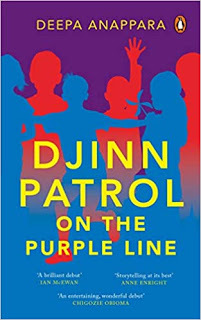 Deepa Anappara’s
Djinn Patrol on the Purple Line
begins with a warm, persuasive little story where rays of hope briefly cut through the blackness of despair: a man named Mental, who employed and was kind to rag-picker boys when he was alive, continues to look out for them after his death. Quietly haunting, this tale – if taken at face value – suggests that the novel will have supernatural elements in it.
Deepa Anappara’s
Djinn Patrol on the Purple Line
begins with a warm, persuasive little story where rays of hope briefly cut through the blackness of despair: a man named Mental, who employed and was kind to rag-picker boys when he was alive, continues to look out for them after his death. Quietly haunting, this tale – if taken at face value – suggests that the novel will have supernatural elements in it.
This question will also be raised during the main narrative, told in the voice of nine-year-old Jai, living in a basti with his impoverished parents (who work for rich, “hi-fi” people) and his elder sister Runu-didi, who wants to be a champion runner. Right at the beginning, Jai tells us he imagines a djinn crouching on the tin roof of their little house, looking at the family through a hole. “Djinns aren’t real,” he then quickly adds, but throughout Djinn Patrol we are invited to think about the possibility of otherworldly beings: good ones like Mental’s ghost (“We need ghosts more than anyone else maybe, because we are railway-station boys without parents and homes,” muses one of his wards), as well as malevolent ones who might be kidnapping and doing unthinkable things to children.
Because that is what the book’s plot-mover is: the vanishing of youngsters from the basti. It begins unobtrusively, with the disappearance of a boy who might have run away from a bad home situation – something that is commonplace here – but then escalates. When it becomes obvious that a crime wave is on, Jai, a fan of TV shows like Police Patrol, decides to play detective. Joining him on various legs of his investigations are his friends: Faiz, the precocious Pari, and occasionally a dog named Samosa.
They wander the basti and its marketplace, conjecturing, asking the questions they think should be asked. They visit the forbidden brothel area where one of the vanished girls is said to have worked. In what for them is a very big journey, Jai and Pari even take the Purple Line metro to the city’s main railway station to make enquiries. All this feels like a grand adventure at first, but there are also weeping parents, corrupt cops, the glowering son of a local Pradhan, a rising paranoia in the air. And Jai must deal with personal demons: guilt-stricken about having pilfered some money that his mother had saved, he tries to earn it back by working at a tea-shop before she finds out.
This is classic coming-of-age material where extraordinary events heighten a child’s senses, lead him to engage more closely with the world immediately around him, to try and interpret – with a few inevitable missteps – what he is seeing and hearing. The surface similarities between Djinn Patrol and Harper Lee’s To Kill a Mockingbird become clearer when a local Hindu-chauvinist group starts blaming the basti’s Muslims for the disappearances: like Lee’s book, this one involves a child’s realisation that what a prejudiced or narrow-minded society teaches one to fear or hate is not necessarily where the real threat lies.
But this novel is also of its place and time. It is about the many intersecting dangers facing poor people in India, and how those dangers are inseparable from the circumstances of their lives: fear of the Other, stoked by self-serving politicians; the bullying police, taking haftas in exchange for very conditional protection; the terrifying bulldozers that are always on the periphery of their world, threatening to raze it – and always, in the distance, the predatory or the apathetic rich, including employers who can’t be supportive even when the mother of a missing child needs to take a couple of days’ leave. Life here can often seem like a horror film where a variety of monsters must be ducked, or like an obstacle race full of potholes.
There is at least a degree of emotional security in the life of the main family: Jai and Runu’s parents have an affectionate relationship; the father, unlike many other fathers, is caring and responsible. And this means Jai is well-placed to observe and comment on the troubles of others. At the same time, the novel’s structure gives us occasional, welcoming breaks from his perspective. Apart from the three main interludes – the stories that “will save your life”, the slivers of hope for poor people in different situations – Anappara also includes a chapter about each of the missing children, where we learn about their inner lives and the circumstances that made them vulnerable to djinns or earthly villains.
****
I had a few minor issues with the main narrative voice. One understands, of course, that there is a filter between what Jai is thinking or describing and what we Anglophone readers are receiving; that the author is “translating” for us. But there were times where I felt a disconnect between prose and setting, where the writing felt a bit too polished, even precious.
This is not to demand a broken or pidgin form of English to convey a basti boy’s speech, but to ask for tonal consistency. On the one hand, Jai's voice contains elegant, fully formed sentences like "The dangly bulb above me hums with hot current, and its shadow swishes over the shelves, the cracks on the wall, and the watermarks from monsoon floods" or "Now the farmers sit at home, boredom curling out of their mouths and noses in clouds of hookah smoke". But every now and again, there is childlike slang – words like “detectiving”, the use of "third of all, fourth of all" (in a list of points that begins "first of all") – or the sudden appearance of street Hindi. His ma, he tells us, "only bak-baks about her bad boss-lady". Elsewhere, "Omvir's brother is susu-ing into the drain". In one place, Jai refers to “pots and jerrycans” but in another we get “plastic chairs and charpais”.
That’s a limited criticism, though, and certainly not a deal-breaker, because on the whole I enjoyed this novel very much. Here is the main reason: it is fluid and well-paced, and despite the fact that it isn’t made up of cliff-hangers (some chapters are almost like self-contained vignettes), each time I finished a chapter, I looked forward to sinking into the next one. These are not trivial achievements, given that so much of Indian English fiction these days is self-consciously turgid at a sentence-by-sentence level – even when one appreciates the quality of thought and intention, or gets what the author is aiming for. (A few days before reading Djinn Patrol on the Purple Line, I finished a Big Book that was chockful of admirable themes and a capacious worldview, but turned into a slog midway through.)
Djinn Patrol deals with Big Picture things: the crippling, self-cannibalising nature of poverty, how divide-and-rule communalism can take a very specific form when poor people are oppressed by a spectrum of more powerful people, working in collusion. But it is also a depiction of the day-to-day lives of children navigating a world, how a community helps each other in little ways and isn’t so helpful at other times, the challenges faced by independent-minded people in an environment that isn’t conducive to such ambitions. The toilet-queue politics of the basti. School life in a milieu where teachers might have reason to be scared of unruly older children even as some of the younger kids try to concentrate on their lessons.
At one point, mentioning a poem that he has to learn by heart, Jai says “The poem wants to know why the moon is sliced in half on some days and why it’s a circle on other days. The worst thing about the poem is that it doesn’t answer its own question.” Understandably, like most other children his age – and perhaps most adults too – he expects clear-cut answers to life’s many questions. Without giving away spoilers, as the book reaches its climax there is a deliberate, deflating sense that such answers might not come easily, that there might not be Police Patrol-like dénouements and neatly wrapped-up endings. A story, it turns out, might not be enough to save your life – though it can provide temporary refuge, and sometimes that’s good enough.
[Earlier reviews for Scroll are here]
-----------------
 Deepa Anappara’s
Djinn Patrol on the Purple Line
begins with a warm, persuasive little story where rays of hope briefly cut through the blackness of despair: a man named Mental, who employed and was kind to rag-picker boys when he was alive, continues to look out for them after his death. Quietly haunting, this tale – if taken at face value – suggests that the novel will have supernatural elements in it.
Deepa Anappara’s
Djinn Patrol on the Purple Line
begins with a warm, persuasive little story where rays of hope briefly cut through the blackness of despair: a man named Mental, who employed and was kind to rag-picker boys when he was alive, continues to look out for them after his death. Quietly haunting, this tale – if taken at face value – suggests that the novel will have supernatural elements in it.This question will also be raised during the main narrative, told in the voice of nine-year-old Jai, living in a basti with his impoverished parents (who work for rich, “hi-fi” people) and his elder sister Runu-didi, who wants to be a champion runner. Right at the beginning, Jai tells us he imagines a djinn crouching on the tin roof of their little house, looking at the family through a hole. “Djinns aren’t real,” he then quickly adds, but throughout Djinn Patrol we are invited to think about the possibility of otherworldly beings: good ones like Mental’s ghost (“We need ghosts more than anyone else maybe, because we are railway-station boys without parents and homes,” muses one of his wards), as well as malevolent ones who might be kidnapping and doing unthinkable things to children.
Because that is what the book’s plot-mover is: the vanishing of youngsters from the basti. It begins unobtrusively, with the disappearance of a boy who might have run away from a bad home situation – something that is commonplace here – but then escalates. When it becomes obvious that a crime wave is on, Jai, a fan of TV shows like Police Patrol, decides to play detective. Joining him on various legs of his investigations are his friends: Faiz, the precocious Pari, and occasionally a dog named Samosa.
They wander the basti and its marketplace, conjecturing, asking the questions they think should be asked. They visit the forbidden brothel area where one of the vanished girls is said to have worked. In what for them is a very big journey, Jai and Pari even take the Purple Line metro to the city’s main railway station to make enquiries. All this feels like a grand adventure at first, but there are also weeping parents, corrupt cops, the glowering son of a local Pradhan, a rising paranoia in the air. And Jai must deal with personal demons: guilt-stricken about having pilfered some money that his mother had saved, he tries to earn it back by working at a tea-shop before she finds out.
This is classic coming-of-age material where extraordinary events heighten a child’s senses, lead him to engage more closely with the world immediately around him, to try and interpret – with a few inevitable missteps – what he is seeing and hearing. The surface similarities between Djinn Patrol and Harper Lee’s To Kill a Mockingbird become clearer when a local Hindu-chauvinist group starts blaming the basti’s Muslims for the disappearances: like Lee’s book, this one involves a child’s realisation that what a prejudiced or narrow-minded society teaches one to fear or hate is not necessarily where the real threat lies.
But this novel is also of its place and time. It is about the many intersecting dangers facing poor people in India, and how those dangers are inseparable from the circumstances of their lives: fear of the Other, stoked by self-serving politicians; the bullying police, taking haftas in exchange for very conditional protection; the terrifying bulldozers that are always on the periphery of their world, threatening to raze it – and always, in the distance, the predatory or the apathetic rich, including employers who can’t be supportive even when the mother of a missing child needs to take a couple of days’ leave. Life here can often seem like a horror film where a variety of monsters must be ducked, or like an obstacle race full of potholes.
There is at least a degree of emotional security in the life of the main family: Jai and Runu’s parents have an affectionate relationship; the father, unlike many other fathers, is caring and responsible. And this means Jai is well-placed to observe and comment on the troubles of others. At the same time, the novel’s structure gives us occasional, welcoming breaks from his perspective. Apart from the three main interludes – the stories that “will save your life”, the slivers of hope for poor people in different situations – Anappara also includes a chapter about each of the missing children, where we learn about their inner lives and the circumstances that made them vulnerable to djinns or earthly villains.
****
I had a few minor issues with the main narrative voice. One understands, of course, that there is a filter between what Jai is thinking or describing and what we Anglophone readers are receiving; that the author is “translating” for us. But there were times where I felt a disconnect between prose and setting, where the writing felt a bit too polished, even precious.
This is not to demand a broken or pidgin form of English to convey a basti boy’s speech, but to ask for tonal consistency. On the one hand, Jai's voice contains elegant, fully formed sentences like "The dangly bulb above me hums with hot current, and its shadow swishes over the shelves, the cracks on the wall, and the watermarks from monsoon floods" or "Now the farmers sit at home, boredom curling out of their mouths and noses in clouds of hookah smoke". But every now and again, there is childlike slang – words like “detectiving”, the use of "third of all, fourth of all" (in a list of points that begins "first of all") – or the sudden appearance of street Hindi. His ma, he tells us, "only bak-baks about her bad boss-lady". Elsewhere, "Omvir's brother is susu-ing into the drain". In one place, Jai refers to “pots and jerrycans” but in another we get “plastic chairs and charpais”.
That’s a limited criticism, though, and certainly not a deal-breaker, because on the whole I enjoyed this novel very much. Here is the main reason: it is fluid and well-paced, and despite the fact that it isn’t made up of cliff-hangers (some chapters are almost like self-contained vignettes), each time I finished a chapter, I looked forward to sinking into the next one. These are not trivial achievements, given that so much of Indian English fiction these days is self-consciously turgid at a sentence-by-sentence level – even when one appreciates the quality of thought and intention, or gets what the author is aiming for. (A few days before reading Djinn Patrol on the Purple Line, I finished a Big Book that was chockful of admirable themes and a capacious worldview, but turned into a slog midway through.)
Djinn Patrol deals with Big Picture things: the crippling, self-cannibalising nature of poverty, how divide-and-rule communalism can take a very specific form when poor people are oppressed by a spectrum of more powerful people, working in collusion. But it is also a depiction of the day-to-day lives of children navigating a world, how a community helps each other in little ways and isn’t so helpful at other times, the challenges faced by independent-minded people in an environment that isn’t conducive to such ambitions. The toilet-queue politics of the basti. School life in a milieu where teachers might have reason to be scared of unruly older children even as some of the younger kids try to concentrate on their lessons.
At one point, mentioning a poem that he has to learn by heart, Jai says “The poem wants to know why the moon is sliced in half on some days and why it’s a circle on other days. The worst thing about the poem is that it doesn’t answer its own question.” Understandably, like most other children his age – and perhaps most adults too – he expects clear-cut answers to life’s many questions. Without giving away spoilers, as the book reaches its climax there is a deliberate, deflating sense that such answers might not come easily, that there might not be Police Patrol-like dénouements and neatly wrapped-up endings. A story, it turns out, might not be enough to save your life – though it can provide temporary refuge, and sometimes that’s good enough.
[Earlier reviews for Scroll are here]
Published on March 14, 2020 21:36
March 13, 2020
A podcast about Gol Maal and other Hindi-film comedies
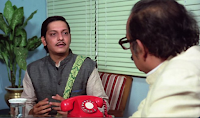 For anyone interested, here is a podcast I was invited to participate in, at Love of Cinema. It centres on Hrishikesh Mukherjee's Gol Maal, and I had fun discussing such things as the themes of masquerade and self-discovery, the contributions of Utpal Dutt and Rahi Masoom Raza, and the spectrum of comedy in Hrishi-da's films (from Deven Varma's deadpan "shabd-phenk" to the broad slapstick in one of my favourite HM films Biwi aur Makaan). Though I also had to clarify at one point that my book was more analytical than anecdote-driven, so I didn't have lots of behind-the-scenes tidbits at hand.
For anyone interested, here is a podcast I was invited to participate in, at Love of Cinema. It centres on Hrishikesh Mukherjee's Gol Maal, and I had fun discussing such things as the themes of masquerade and self-discovery, the contributions of Utpal Dutt and Rahi Masoom Raza, and the spectrum of comedy in Hrishi-da's films (from Deven Varma's deadpan "shabd-phenk" to the broad slapstick in one of my favourite HM films Biwi aur Makaan). Though I also had to clarify at one point that my book was more analytical than anecdote-driven, so I didn't have lots of behind-the-scenes tidbits at hand. Do listen if you have the time and interest. Here's the link again.
Published on March 13, 2020 19:13
March 7, 2020
Humour and fantasy in Arvind Desai and Chhoti si Baat
[My “One Moment Please” column for The Hindu – about two scenes from Hindi films of the 1970s, about the use of soft weapons against privilege]
-------------------
Revisiting two 1970s Hindi films recently, I was struck by light-hearted scenes that showed how the underprivileged can deal with the privileged without direct confrontation. Humour, including biting sarcasm, can be one such tool; so can pure fantasy, which allows you to “reverse” a situation – even if the reversal occurs only in your head.
Rich lad Arvind Desai buys four bottles of Black Label (beer, not whisky!) at a shop. He hands over a currency note and then walks away clutching the bottles as the vendor’s assistant calls out to him to take the change. But instead of being grateful for this casually bestowed “tip”, the shopkeeper shakes his head and chuckles: “Rehne do, yaar. Saalon ko paise lene mein bhi takleef hoti hai.” (“These wealthy people find it troublesome to even take their money back.”)
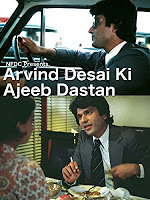 In an earlier scene in this film, Saeed Mirza’s Arvind Desai ki Ajeeb Dastaan, the protagonist – heir to a business empire but also a troubled young man experiencing a nascent form of political awareness – has a self-congratulatory glow on his face after showing kindness to a street boy. But we then see this boy making fun of Arvind behind his back.
In an earlier scene in this film, Saeed Mirza’s Arvind Desai ki Ajeeb Dastaan, the protagonist – heir to a business empire but also a troubled young man experiencing a nascent form of political awareness – has a self-congratulatory glow on his face after showing kindness to a street boy. But we then see this boy making fun of Arvind behind his back.
Mirza’s film offers more hard-hitting variants on the theme of the poor meeting the privileged gaze: it ends with exploited carpet-weavers staring accusingly at the camera. But that casual ten-second scene at the theka operates in a much lighter register, wittily undercutting the self-congratulatory delusions of the “benevolent” rich and making a sly observation about the Indian class waltz, one that is equally pertinent in the soft-socialist and the post-economic liberalisation eras.
The scene might also make you ask what Arvind was really intending to do, a question that is inseparable from the casting of the young and callow Dilip Dhawan in the part. Dhawan, though very likable, had a limited acting range, so you wonder: was Arvind airily walking away after leaving a tip, or was he just sheepish – as many of us are – about hanging around to collect a small amount?
Either way, I think of the scene often. There was a time when, if someone was delivering food to my door and the bill came to, say, Rs 490, I would hand over a 500 note and mutter “Rehne deejiye” if the man started to look in his pocket for change. After watching the film, if I find myself in the same situation, I will make sure to hand over another thirty or forty rupees so the tip seems more substantial. And it isn’t just heightened sensitivity, it’s also because a part of me thinks this will reduce my chances of being mocked: the delivery man might not joke about me with his friends; the status quo between us will remain.
If Arvind Desai ki Ajeeb Dastaan was part of what became known as the parallel movement or the cinema of struggle, a very different treatment of the lack-of-privilege theme can be seen in the gentle comedy-romances from the so-called Middle Cinema. Take a scene from Basu Chatterjee’s Chhoti si Baat, an archetype of the cosy “middle-class film”. The diffident Arun (Amol Palekar) can barely bring himself to speak to the girl he likes (Prabha, played by Vidya Sinha), but then he goes to a hall and watches a film where a mainstream hero has no such confidence issues. As the brawny Dharmendra sings “Jaaneman Jaaneman” to Hema Malini, Arun imagines himself and Prabha in their place on the screen, and there is even a marvellous moment where the transition from the big movie stars to the everymen is briefly left incomplete – so that we see Dharmendra crooning to Vidya Sinha for a few seconds. Two universes have brushed against each other.
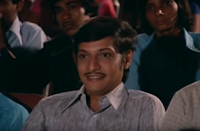 The Middle Cinema often shows us what form fantasy can take in ordinary lives and everyday contexts (another such scene that comes to mind is Palekar imagining himself as a big star while a jobless Amitabh Bachchan languishes outside a studio in Gol Maal) – and while this is often presented as fun and games, it is also a view of the underdog lording it over the pampered poodle. Imagination does have its limits, though: the shirt Palekar wears in the “Jaaneman” fantasy sequence appears two sizes too big, as if it had been fitted for Dharmendra’s muscular chest.
The Middle Cinema often shows us what form fantasy can take in ordinary lives and everyday contexts (another such scene that comes to mind is Palekar imagining himself as a big star while a jobless Amitabh Bachchan languishes outside a studio in Gol Maal) – and while this is often presented as fun and games, it is also a view of the underdog lording it over the pampered poodle. Imagination does have its limits, though: the shirt Palekar wears in the “Jaaneman” fantasy sequence appears two sizes too big, as if it had been fitted for Dharmendra’s muscular chest.
[Earlier Hindu columns are here]
-------------------
Revisiting two 1970s Hindi films recently, I was struck by light-hearted scenes that showed how the underprivileged can deal with the privileged without direct confrontation. Humour, including biting sarcasm, can be one such tool; so can pure fantasy, which allows you to “reverse” a situation – even if the reversal occurs only in your head.
Rich lad Arvind Desai buys four bottles of Black Label (beer, not whisky!) at a shop. He hands over a currency note and then walks away clutching the bottles as the vendor’s assistant calls out to him to take the change. But instead of being grateful for this casually bestowed “tip”, the shopkeeper shakes his head and chuckles: “Rehne do, yaar. Saalon ko paise lene mein bhi takleef hoti hai.” (“These wealthy people find it troublesome to even take their money back.”)
 In an earlier scene in this film, Saeed Mirza’s Arvind Desai ki Ajeeb Dastaan, the protagonist – heir to a business empire but also a troubled young man experiencing a nascent form of political awareness – has a self-congratulatory glow on his face after showing kindness to a street boy. But we then see this boy making fun of Arvind behind his back.
In an earlier scene in this film, Saeed Mirza’s Arvind Desai ki Ajeeb Dastaan, the protagonist – heir to a business empire but also a troubled young man experiencing a nascent form of political awareness – has a self-congratulatory glow on his face after showing kindness to a street boy. But we then see this boy making fun of Arvind behind his back.Mirza’s film offers more hard-hitting variants on the theme of the poor meeting the privileged gaze: it ends with exploited carpet-weavers staring accusingly at the camera. But that casual ten-second scene at the theka operates in a much lighter register, wittily undercutting the self-congratulatory delusions of the “benevolent” rich and making a sly observation about the Indian class waltz, one that is equally pertinent in the soft-socialist and the post-economic liberalisation eras.
The scene might also make you ask what Arvind was really intending to do, a question that is inseparable from the casting of the young and callow Dilip Dhawan in the part. Dhawan, though very likable, had a limited acting range, so you wonder: was Arvind airily walking away after leaving a tip, or was he just sheepish – as many of us are – about hanging around to collect a small amount?
Either way, I think of the scene often. There was a time when, if someone was delivering food to my door and the bill came to, say, Rs 490, I would hand over a 500 note and mutter “Rehne deejiye” if the man started to look in his pocket for change. After watching the film, if I find myself in the same situation, I will make sure to hand over another thirty or forty rupees so the tip seems more substantial. And it isn’t just heightened sensitivity, it’s also because a part of me thinks this will reduce my chances of being mocked: the delivery man might not joke about me with his friends; the status quo between us will remain.
If Arvind Desai ki Ajeeb Dastaan was part of what became known as the parallel movement or the cinema of struggle, a very different treatment of the lack-of-privilege theme can be seen in the gentle comedy-romances from the so-called Middle Cinema. Take a scene from Basu Chatterjee’s Chhoti si Baat, an archetype of the cosy “middle-class film”. The diffident Arun (Amol Palekar) can barely bring himself to speak to the girl he likes (Prabha, played by Vidya Sinha), but then he goes to a hall and watches a film where a mainstream hero has no such confidence issues. As the brawny Dharmendra sings “Jaaneman Jaaneman” to Hema Malini, Arun imagines himself and Prabha in their place on the screen, and there is even a marvellous moment where the transition from the big movie stars to the everymen is briefly left incomplete – so that we see Dharmendra crooning to Vidya Sinha for a few seconds. Two universes have brushed against each other.
 The Middle Cinema often shows us what form fantasy can take in ordinary lives and everyday contexts (another such scene that comes to mind is Palekar imagining himself as a big star while a jobless Amitabh Bachchan languishes outside a studio in Gol Maal) – and while this is often presented as fun and games, it is also a view of the underdog lording it over the pampered poodle. Imagination does have its limits, though: the shirt Palekar wears in the “Jaaneman” fantasy sequence appears two sizes too big, as if it had been fitted for Dharmendra’s muscular chest.
The Middle Cinema often shows us what form fantasy can take in ordinary lives and everyday contexts (another such scene that comes to mind is Palekar imagining himself as a big star while a jobless Amitabh Bachchan languishes outside a studio in Gol Maal) – and while this is often presented as fun and games, it is also a view of the underdog lording it over the pampered poodle. Imagination does have its limits, though: the shirt Palekar wears in the “Jaaneman” fantasy sequence appears two sizes too big, as if it had been fitted for Dharmendra’s muscular chest.[Earlier Hindu columns are here]
Published on March 07, 2020 08:50
February 13, 2020
Thoughts on the Parasite win, and the grand illusion of the “international” Oscars
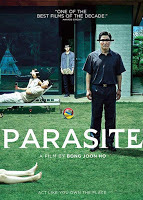 [Did this opinion piece for Open magazine. I prefer not to write these pontificating-about-the-Oscars essays any more – competitive awards processes lend themselves to some very simplistic analyses, and everyone gets sucked into the narrative-constructing. Besides, the Oscars in my view are most interesting up to the nomination-announcement stage, and before that, when one is speculating about the nominees. By the time one arrives at the big night itself, everything is blah and annoying, even when there are surprise winners (and no matter what happens, the Facebook feeds of excited movie buffs around this time can be unbearable).
[Did this opinion piece for Open magazine. I prefer not to write these pontificating-about-the-Oscars essays any more – competitive awards processes lend themselves to some very simplistic analyses, and everyone gets sucked into the narrative-constructing. Besides, the Oscars in my view are most interesting up to the nomination-announcement stage, and before that, when one is speculating about the nominees. By the time one arrives at the big night itself, everything is blah and annoying, even when there are surprise winners (and no matter what happens, the Facebook feeds of excited movie buffs around this time can be unbearable).But despite my aversion to “topical” pieces of this sort, it’s nice to occasionally write about something that everyone else is also bloviating about]
-----------------------
“It is what it is,” says one man to another in a pivotal scene in Martin Scorsese’s The Irishman, which – as you probably know by now – failed to win anything at this year’s Oscars despite multiple nominations. In the film this line has a sinister undercurrent, being a gangster’s quiet warning: tell your friend not to rock the boat, or action will be taken against him. But these are also the words that most often come to my mind when asked to comment on Oscar choices and the big narratives surrounding this or that win.
Because, well, the Academy Awards are what they are. A grand, self-congratulatory carnival – often genuinely and stirringly sentimental – that has become by default THE show, because of its long history in the world’s most high-profile film industry. A show that has, with a few notable exceptions, tended to reward a very specific sort of solid, middlebrow film: neither too radical nor too popular. Enthusiastic movie buffs use up much bandwidth to analyse and explain Oscar results through their own prisms: why the winning film (if they loved it) deserved to win, being “objectively” superior to the competition; or (if it wasn’t their choice) why the Academy made a mistake or got swayed. But to those who know Oscar history well, the patterns and quirks have always been there, among them the neglect of comedies and comic performances, even great ones; the “holdover prize” for a respected figure who didn’t win for his or her best work but must be honoured somehow, even if for a lesser achievement; the strong bias towards films that are “respectable” in superficial and obvious ways (but they mustn’t be too esoteric for a general audience).
In this light, it’s amusing to note that the two men in that Irishman scene are old and white and played by Hollywood legends Robert De Niro and Joe Pesci – the types whom we think of as part of the Establishment, the ones who make the more conservative-seeming Oscar decisions.
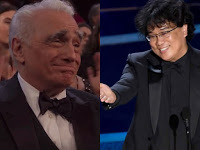 This year, with top honours going to Parasite (a Korean film! with subtitles!), the Oscars departed from the “it is what it is” formula. Even though director Bong Joon Ho paid effusive tribute to Scorsese during his speech – allowing us to think of the moment as a continuation of a cinematic legacy rather than a disruption – the Parasite wins brought a sense of newness and danger to the proceedings, a sense that Oscar had gone a step further in recognising diversity than when it gave Slumdog Millionaire (a British film with Indian DNA) all those awards in 2009, or when it crowned Barry Jenkins’s Moonlight – an unconventional, low-key story with a protagonist who is both black and gay – three years ago.
This year, with top honours going to Parasite (a Korean film! with subtitles!), the Oscars departed from the “it is what it is” formula. Even though director Bong Joon Ho paid effusive tribute to Scorsese during his speech – allowing us to think of the moment as a continuation of a cinematic legacy rather than a disruption – the Parasite wins brought a sense of newness and danger to the proceedings, a sense that Oscar had gone a step further in recognising diversity than when it gave Slumdog Millionaire (a British film with Indian DNA) all those awards in 2009, or when it crowned Barry Jenkins’s Moonlight – an unconventional, low-key story with a protagonist who is both black and gay – three years ago. In the wake of the ceremony, there was much chatter on Indian social media, from jokes in the Bengali community about how a “Bong” had made them proud, to pedantic declarations about how the director had made better films in the past; how he should have won for Memories of Murder. On the whole, though, the feeling is that a brave new world has been born.
But while Parasite is in the books as the first non-English-language film to win best picture, this may not be the ceiling-shattering event it is made out to be.
Because Oscar does have a tradition of doing something unpredictable every now and again – in keeping with a zeitgeist – before returning happily to its comfort zone. And Parasite ticks many boxes for the sort of “international” film that the Academy would find easy to endorse. It is from a country whose cinematic culture has long been celebrated by knowledgeable movie buffs; it is helmed by a widely admired director who has also made a couple of films in English (with American actors) and collaborated with Hollywood studios such as the Weinstein Company. It won the top prize at Cannes last year, had a buzz around it, and subtitles notwithstanding, it is fast-paced and translates well across cultures. With its twist-laden narrative about a lower-class family who manage to infiltrate the lives of the rich, it works both as piercing class commentary – a “message” movie – and as a clever thriller-horror-comedy. (Traditionally, Oscar hasn’t been kind to genre films – unless it is made painfully explicit that the use of a genre is a cover for the exploration of “deep” or “serious” ideas.) It’s easy to see why Parasite’s theme of “crossing a line” (a class-related reference made in the story) may have been irresistible to the Academy when it set out to erase one of its own lines this year, to move beyond “it is what it is”.
Just to clarify, I have nothing against Parasite (though I wasn’t as blown away by the film as many others have been). Its wins are worth celebrating, feeling good about, and using as a pretext to discover cinematic riches from Korea and other cultures (and getting over the fear of subtitles). But I do baulk a little when I see fans exulting as if Bong Joon Ho had wrested the statuette out of reluctant hands by making a film that simply couldn’t be denied; as if the achievement wasn’t tied to a shift in the terms of admission and engagement within the Academy itself. (A cynic might even say: here’s a stuffy old organisation doing a bit of PR for itself by allowing an outsider into its gates for a short while.)
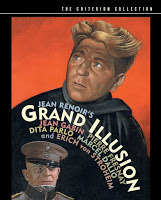 Consider some of the earlier filmmakers who “failed” to win best picture, starting with the legendary Jean Renoir whose masterful La Grande Illusion was the first non-English-language film to be nominated for the top award, in 1938. Interestingly, a full thirty-one years would elapse before the second such instance – never mind that those three decades saw an extraordinary flowering of “world cinema”, with waves of creative output from several countries, and the peak work of such directors as Akira Kurosawa, Jean-Luc Godard, Ingmar Bergman, Luis Bunuel, Yasujiro Ozu, Satyajit Ray and many others.
Consider some of the earlier filmmakers who “failed” to win best picture, starting with the legendary Jean Renoir whose masterful La Grande Illusion was the first non-English-language film to be nominated for the top award, in 1938. Interestingly, a full thirty-one years would elapse before the second such instance – never mind that those three decades saw an extraordinary flowering of “world cinema”, with waves of creative output from several countries, and the peak work of such directors as Akira Kurosawa, Jean-Luc Godard, Ingmar Bergman, Luis Bunuel, Yasujiro Ozu, Satyajit Ray and many others. In other words, for much of Oscar’s lifespan, hundreds of iconic non-English-language films weren't treated as serious contenders in the major categories. The eligibility criterion for a foreign-language film – it must have a Los Angeles release – was of course a sieve, but countless great foreign films missed getting a Best Picture nomination. (Parasite is only the twelfth such film in that category. The list of eligible masterpieces that didn’t make it is way too long to list here, but consider that films like Kurosawa’s Rashomon and The Seven Samurai were nominated only for technical awards such as art direction.)
While there was honesty about the fact that the major awards were reserved for American (sometimes British) films, there was also some tokenism, which muddied the waters. For instance, the period 1960 to 1979 saw a total of sixteen best director nominations for non-English-language films – no wins, and never more than one such nomination in a year; this amounted to proclaiming that the Oscars were a truly international award, but that four of the five supreme directing achievements in a given year just happened to be American.
Things do change, of course, and horizons have been broadened, goalposts shifted, at different times in Oscar history, whether the catalyst was Sidney Poitier’s best actor win in 1964 or Linda Hunt winning best supporting actress for playing a male character in 1983. (Perceptions shift with the decades, too: consider that if The Irishman had won the top awards this year, it would have felt like a relatively conservative decision. But back in 1980, another Scorsese film starring De Niro and Pesci, Raging Bull, was too edgy and unconventional for the Oscars to award it best picture.) You might say, why argue with progress?
But does the Parasite win signal a real shift towards inclusivity? How meaningful can such a shift be? And there is the broader question: should the Oscars be going international in this particular way? Does it make sense for an award ceremony that has always been about Anglophone cinema to move away from its core strengths, and to attempt – with inevitably unsatisfying results – to become all things to all cinemas? When you set out to do that, it can’t be half-measured. You have to be able to encompass a breath-taking number of forms, styles and culture-specific content, including works that don’t translate well, even with good subtitling.
Around a decade and a half ago, I had a long online chat about the best foreign-language film category with a fellow film buff (and future director). The context was Lagaan losing to No Man’s Land, we discussed a third film too, and agreed that these movies represented such different schools that comparing them was hubristic. The foreign-language film category pretended that there was a single yardstick by which movies from around the world could be judged, and that this could be reasonably done by an American academy, the majority of whose members have grown up with narrow ideas about what good cinema or good art should look like. That’s an insult to the variety in the medium.
Now that the floodgates have opened and films like Roma and Parasite have become serious contenders – eventually even winners – in the main categories, this discussion applies to all of the Oscars, not just to the foreign-language-film award.
I don’t know if this is a workable option, but I wish the Academy would let the main Oscars stay as they mostly have been, and to follow something like the Man Booker Prize model: have a separate "international" ceremony – with the same award categories – for non-English-language films. Retain the Oscar brand and prestige, put together juries of people who are so diverse in their tastes – and in their exposure to different artistic expressions – that it will be almost impossible to predict, from one year to the next, whether an award might go to a stylized Korean thriller, an understated, humanistic Iranian work, a gritty Malayalam narrative or even a well-made song-and-dance Hindi movie. And if that sounds too messy, chaotic and capricious, well, that’s what real diversity looks like.
Published on February 13, 2020 05:44
February 11, 2020
On Nandita Das’s Manto & I
[Did this short review for India Today. An earlier post about Manto the film is here]
------------------
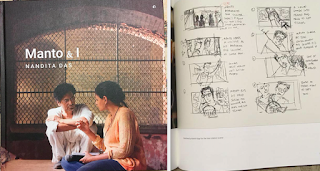 One expects a good coffee-table book to look classy and to be informative, but one doesn’t necessarily hope for very personal writing within its pages. Nandita Das’s Manto & I is a pleasing exception. A single, very particular voice runs through it: the voice of a reader, writer and director who became deeply interested in Saadat Hasan Manto and eventually realised her dream of making a film about him. Much as I had enjoyed Das’s 2018 film Manto, it was only after reading this book that I fully appreciated her role as auteur, carefully maintaining control over every department of the process.
One expects a good coffee-table book to look classy and to be informative, but one doesn’t necessarily hope for very personal writing within its pages. Nandita Das’s Manto & I is a pleasing exception. A single, very particular voice runs through it: the voice of a reader, writer and director who became deeply interested in Saadat Hasan Manto and eventually realised her dream of making a film about him. Much as I had enjoyed Das’s 2018 film Manto, it was only after reading this book that I fully appreciated her role as auteur, carefully maintaining control over every department of the process.
Das places Manto in context, discusses the aspects of his art and life that she was drawn to, as well as his many human contradictions, the searing honesty that brought him much trouble during his short lifetime (and which continues to divide his readers today), and his relevance to our contemporary discourse. She discusses the film’s conceptualisation and the bond she formed with Manto’s three daughters. There are notes on casting, music, production design, the many little decisions and happenstances (some forced by budgetary constraints) that go into making a film what it eventually becomes, and the post-completion frustrations faced by a “small” movie during distribution and promotion.
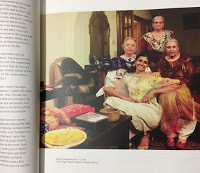 The many fascinating insights into the creative process include one about the decision to incorporate five of Manto’s short stories into the structure of this biopic, so that they play as short films within the film. Challenging as it was to pull this off (among the things discussed with cinematographer Kartik Vijay was whether a separate colour scheme should be used for each interlude), Das also mentions how satisfying it was when Manto’s most famous story “Toba Tek Singh” – which she had always intended to end the film with – found itself organically in just the right spot when the script was being written. This serendipity (“It is magical when such things happen”) is something many writers will relate to.
The many fascinating insights into the creative process include one about the decision to incorporate five of Manto’s short stories into the structure of this biopic, so that they play as short films within the film. Challenging as it was to pull this off (among the things discussed with cinematographer Kartik Vijay was whether a separate colour scheme should be used for each interlude), Das also mentions how satisfying it was when Manto’s most famous story “Toba Tek Singh” – which she had always intended to end the film with – found itself organically in just the right spot when the script was being written. This serendipity (“It is magical when such things happen”) is something many writers will relate to.
Visually, the book is held together by Aditya Varma’s fine photos – including production stills – but the candid writing is what makes it a legitimate addition to our cinema literature. It might have been easier for Das to fully defer to her subject, but she makes it clear that the film was also a reflection of her own personality, beliefs and working methods. “[Manto’s writings] are all deeply political,” she notes, “but the storytelling remains intimate and the lens, humanistic. I have subconsciously found myself doing the same.”
------------------
 One expects a good coffee-table book to look classy and to be informative, but one doesn’t necessarily hope for very personal writing within its pages. Nandita Das’s Manto & I is a pleasing exception. A single, very particular voice runs through it: the voice of a reader, writer and director who became deeply interested in Saadat Hasan Manto and eventually realised her dream of making a film about him. Much as I had enjoyed Das’s 2018 film Manto, it was only after reading this book that I fully appreciated her role as auteur, carefully maintaining control over every department of the process.
One expects a good coffee-table book to look classy and to be informative, but one doesn’t necessarily hope for very personal writing within its pages. Nandita Das’s Manto & I is a pleasing exception. A single, very particular voice runs through it: the voice of a reader, writer and director who became deeply interested in Saadat Hasan Manto and eventually realised her dream of making a film about him. Much as I had enjoyed Das’s 2018 film Manto, it was only after reading this book that I fully appreciated her role as auteur, carefully maintaining control over every department of the process. Das places Manto in context, discusses the aspects of his art and life that she was drawn to, as well as his many human contradictions, the searing honesty that brought him much trouble during his short lifetime (and which continues to divide his readers today), and his relevance to our contemporary discourse. She discusses the film’s conceptualisation and the bond she formed with Manto’s three daughters. There are notes on casting, music, production design, the many little decisions and happenstances (some forced by budgetary constraints) that go into making a film what it eventually becomes, and the post-completion frustrations faced by a “small” movie during distribution and promotion.
 The many fascinating insights into the creative process include one about the decision to incorporate five of Manto’s short stories into the structure of this biopic, so that they play as short films within the film. Challenging as it was to pull this off (among the things discussed with cinematographer Kartik Vijay was whether a separate colour scheme should be used for each interlude), Das also mentions how satisfying it was when Manto’s most famous story “Toba Tek Singh” – which she had always intended to end the film with – found itself organically in just the right spot when the script was being written. This serendipity (“It is magical when such things happen”) is something many writers will relate to.
The many fascinating insights into the creative process include one about the decision to incorporate five of Manto’s short stories into the structure of this biopic, so that they play as short films within the film. Challenging as it was to pull this off (among the things discussed with cinematographer Kartik Vijay was whether a separate colour scheme should be used for each interlude), Das also mentions how satisfying it was when Manto’s most famous story “Toba Tek Singh” – which she had always intended to end the film with – found itself organically in just the right spot when the script was being written. This serendipity (“It is magical when such things happen”) is something many writers will relate to.Visually, the book is held together by Aditya Varma’s fine photos – including production stills – but the candid writing is what makes it a legitimate addition to our cinema literature. It might have been easier for Das to fully defer to her subject, but she makes it clear that the film was also a reflection of her own personality, beliefs and working methods. “[Manto’s writings] are all deeply political,” she notes, “but the storytelling remains intimate and the lens, humanistic. I have subconsciously found myself doing the same.”
Published on February 11, 2020 18:30
February 7, 2020
Privileged, empathetic…and no longer in control: on Hi, Mom! and “Be black, baby”
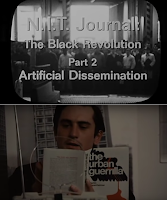 [In my latest Hindu "moments" column: why recent visits to Shaheen Bagh and other protest sites reminded me of a funny, hard-hitting, very political 50-year-old film starring the young Robert De Niro – in a role that anticipated his famous part as Travis Bickle]
[In my latest Hindu "moments" column: why recent visits to Shaheen Bagh and other protest sites reminded me of a funny, hard-hitting, very political 50-year-old film starring the young Robert De Niro – in a role that anticipated his famous part as Travis Bickle]------------------
Two things happened recently that inspired me to revisit a favourite sequence (or really, a film-within-a-film) from an underseen but vital American movie that turns fifty this year. The first incident was after a screening I curated, where the conversation touched on the problematic tradition of “brown-facing” an actor – or, more generally, using someone from a privileged background to play an unprivileged character (especially when the film is centred on themes like social injustice).
 The second was the experience of visiting Shaheen Bagh, the hub of the Delhi protests against the Citizenship Amendment Act (CAA). It was especially invigorating to be here on New Year’s Eve: to see the quiet resilience of the women leading the protest, listen to the poetry being read, the displays of subversive humour, the many little ways in which underdogs can use wit and satire to target the powerful. And yet, throughout, I was aware of my position as someone who was showing a modicum of support (for a few hours) without having much directly at stake – and with no real understanding of what it’s like to be from a class or community or demographic that is under immediate threat.
The second was the experience of visiting Shaheen Bagh, the hub of the Delhi protests against the Citizenship Amendment Act (CAA). It was especially invigorating to be here on New Year’s Eve: to see the quiet resilience of the women leading the protest, listen to the poetry being read, the displays of subversive humour, the many little ways in which underdogs can use wit and satire to target the powerful. And yet, throughout, I was aware of my position as someone who was showing a modicum of support (for a few hours) without having much directly at stake – and with no real understanding of what it’s like to be from a class or community or demographic that is under immediate threat. And I thought again of the virtuous white New Yorkers in “Be Black, Baby”.
This is a segment – three segments, to be exact – within Hi, Mom!, a funny, uneven, savagely political 1970 film made by Brian De Palma. The main narrative involves a deviant amateur filmmaker (played by a pre-stardom Robert De Niro) videotaping people without their knowledge, but woven into this story are the “Be Black, Baby” interludes, shot in grainy black-and-white with a handheld camera – to resemble a low-budget documentary – and scored with a catchy title track by Eric Kaz.
Here is the basic premise of “Be Black Baby”: a troupe of African-American theatre performers go around asking white people if they know what it is like to be black, and offering them firsthand experience. “You can’t intellectualize it,” a black interviewer tells his WASP respondent, “you have to live it.” What follows is a hilariously, deliberately reductive version of this “living it”.
When eager wannabe liberals show up for the participative theatre experience they were promised, they are made to edge closer and closer to the lives of those whom they claim to feel empathy for – and it’s more discomfiting than they expected. Roles are reversed: the black performers, made up in whiteface, smear soot on the faces of the white audience. (“It’s going to ruin my makeup,” squeals a woman who was clearly not expecting to be so inconvenienced) and force-feed them soul food (“To be black and to feel black, you have to eat black”).
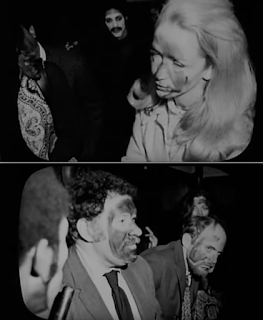 Things quickly escalate, from a purse being taken away, to the threat of violence and rape. Just as the audience members are being assaulted by the black performers (who are now thoroughly in character as white oppressors), the De Niro character Jon shows up as a policeman. And then – this might sound familiar to anyone who has followed recent developments in Indian universities like JNU – instead of protecting the victims, the cop starts haranguing them, demanding ID, and siding with the assaulters.
Things quickly escalate, from a purse being taken away, to the threat of violence and rape. Just as the audience members are being assaulted by the black performers (who are now thoroughly in character as white oppressors), the De Niro character Jon shows up as a policeman. And then – this might sound familiar to anyone who has followed recent developments in Indian universities like JNU – instead of protecting the victims, the cop starts haranguing them, demanding ID, and siding with the assaulters. Both familiar and audacious as all this is, what follows is side-splitting: once their ordeal is over and they know they are safe, the traumatized audience starts gushing about the experience. “Great theatre! I’m going to tell all my friends to come for this […] It really made you feel what it’s like to be a negro…uh, to be black.” In the end, that’s what it was for them – great theatre, to be intellectualized from a distance. The sequence is a lacerating commentary on the delusions of the well-intentioned, how someone else’s reality can be too much to handle up close no matter how righteous you are feeling – and how, once you’re confident about the status quo being restored, you easily revert to the same homilies as before.
There has been much talk about the debt that Todd Phillips’s Joker owes to Martin Scorsese’s Taxi Driver – both films being about anarchist violence as a response to a hopelessly unjust world. But six years before De Niro’s iconic role as Travis Bickle (and half a century before his supporting part in Joker), Hi Mom! dealt with this theme too, especially in its (literally) explosive finale. And neither of those other films, for all their virtues, contain anything as formally experimental and as unnerving as the “Be Black Baby!” scenes.
------------
[Earlier Hindu columns are here]
Published on February 07, 2020 04:39
Jai Arjun Singh's Blog
- Jai Arjun Singh's profile
- 11 followers
Jai Arjun Singh isn't a Goodreads Author
(yet),
but they
do have a blog,
so here are some recent posts imported from
their feed.



